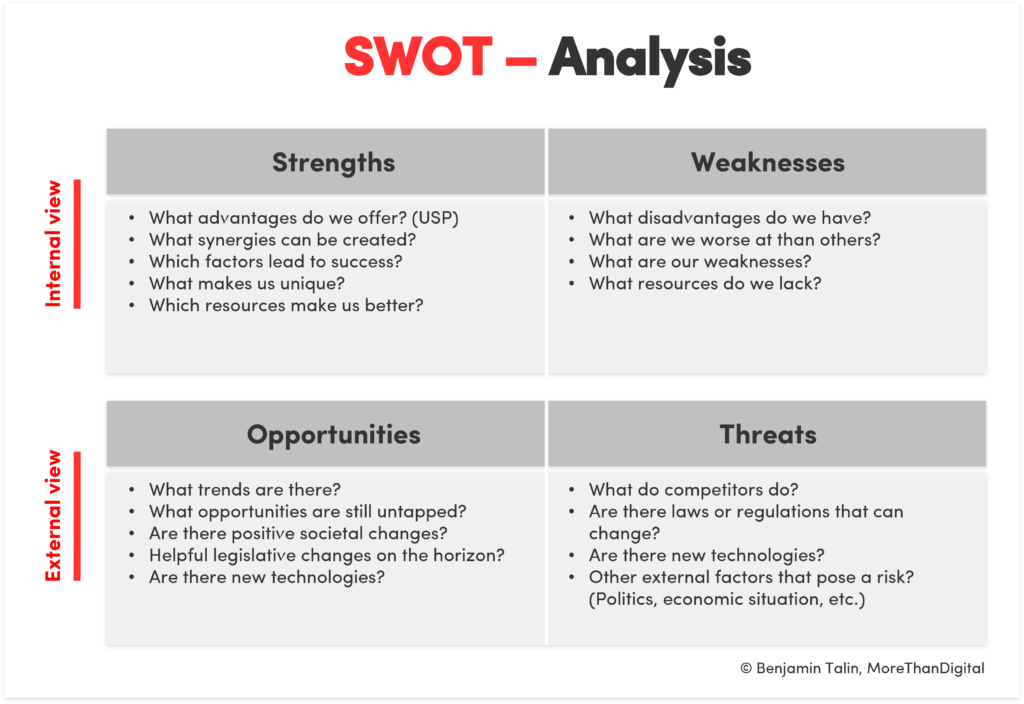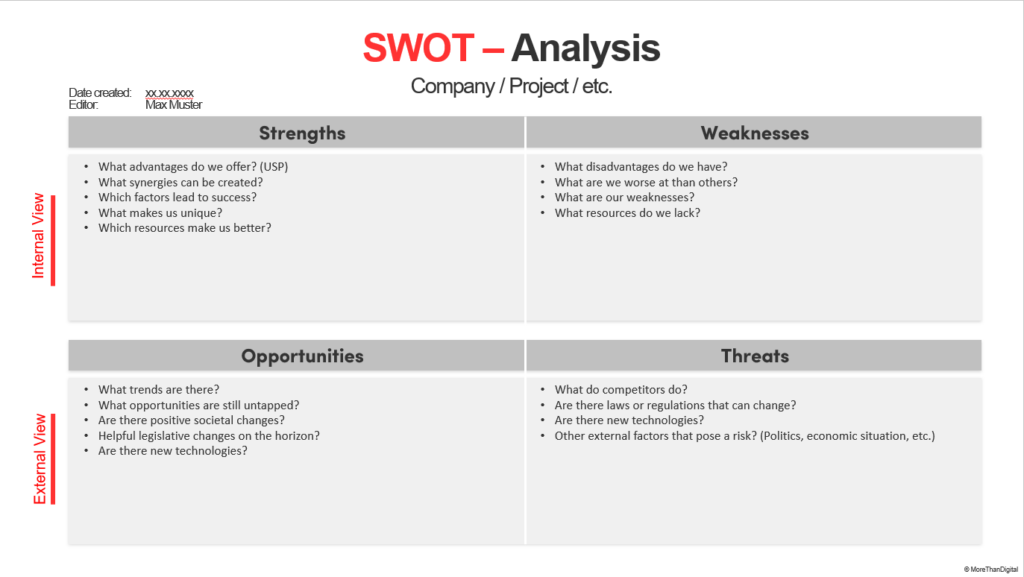SWOT analysis – Definition and 5 steps for a professional SWOT
What is a SWOT analysis and how can you use it for projects, strategy, etc.? - Incl. free Powerpoint SWOT template
A SWOT analysis is often at the beginning of every business plan or idea. It should help to systematically highlight the opportunities and risks, but also to understand your own strengths and weaknesses.
SWOT analysis is known to many from business plans or from banks. It is now seen internationally as a standard, because it can be used quickly and easily for an overview. SWOT is composed of the first letters of the 4 analyzed subareas
- Strengths – Own strengths and advantages
- Weaknesses – Own weaknesses and disadvantages
- Opportunities – Possible chances and future possibilities
- Threats – Possible risks and dangers
Index
Possible applications for SWOT
The SWOT analysis is exciting to use as a simple and basic tool for some areas in the company.
1. Corporate and Strategy SWOT
The classic case to do a SWOT analysis is in corporate strategy or corporate planning. It is also required by many banks for loans or by investors of start-ups.
This SWOT analysis specifically addresses the holistic issues of a company. Sub-areas such as products, customers, markets, partners & suppliers but also employees and internal structures are evaluated.
2. Products / Services SWOT
The SWOT analysis can also be used for specific topics. Products, product lines or services can be analyzed. The strengths/weaknesses of the product are analyzed and important opportunities but also risks in the market, through competition or through production, employees, etc. are highlighted.
3. PR & Marketing SWOT
Also in marketing as well as in PR a SWOT analysis is often created for an easier overview. This involves assessing customer opinions and perceptions, looking at the competition and monitoring your own position in the market.
4. Project SWOT
It is also worth doing a project SWOT analysis. Especially when it comes to more extensive projects, one should also look at the possible risks and opportunities. As a project manager, a SWOT analysis can also help to mitigate the risks and also specifically involve stakeholders for the individual sub-areas.
SWOT analysis – definition and basics
We have already talked a lot about what the SWOT analysis can be used for. Now it is specifically about understanding the 4 sub-areas better.

Internal view – Strenghts & Weaknesses
The internal view is only concerned with the company’s own business. The strengths and weaknesses of all topics are examined in detail. Here, it is purely about the company, project or thhe good to be analyzed – external factors such as laws etc. play no role here.
Strengths
Strengthening is an internal analysis. This involves analyzing how the company is positioned in comparison to the competition, the market, etc. The strengths can be defined in terms of processes, employees, IT, marketing, or other factors. Processes, employees, IT, marketing, but also other factors can play a role.
It also helps to imagine how this could be viewed by others, e.g. competitors. Which topics could they see as a potential threat to their business? These are usually the strengths (strengths). However, it must allow for differentiation. If everyone has the same high quality, then quality is not a strength, but simply a standard.
Weaknesses
Weaknesses also look only at the internal perspective – where are our internal weaknesses? Topics such as personnel, resources, brand, positioning, but also processes and systems are analyzed. The aim is to identify all topics that are worthy of improvement and may need to be adjusted.
Here, one could also take an external view and consider how a customer or a competitor would evaluate the company as a whole. Where are you weaker than the competition and where is there room for improvement?
Especially here it is important to be honest and also realistic, because many entrepreneurs are often silent about this, which leads to another problem – more about this later.
External view – Opportunities & Threats
This view is completely dedicated to all topics that happen around the company, project, etc.. External factors include laws, regulations, market dynamics and many other topics. Here it is purely about external factors and internal company issues are anlysiert at strengths and weaknesses.
Opportunities
The opportunities are an external view. One tries to pick up positive chances and opportunities in order to use them for oneself. Market trends, positive legislation, new technologies to be used and many other topics can play a role.
Everything that can lead to short or long term advantages should be listed here. These opportunities should also be used, among other things, in order to make better progress oneself and to be able to position oneself better as a result.
Threats
Another external perspective is, of course, the risks that can arise from changing environmental variables. For example, political instability, changing market conditions, scarcity of labor, but also changing technologies can pose a risk.
It is important to do a broad search here, as there can be many issues that can pose a potential risk. Strategically, one should also go and provide these risks either to mitigate or possibly even transform as an opportunity.
With risks, it also pays to know the probabilities and the financial risks associated with them. How likely is it to occur? What would it mean for us? – If there are very probable risks, which should be very drastic for the business, then one should spend extra time to make plans for them.
5 steps for a professional SWOT analysis
Now that we know the basics for the SWOT analysis, we should follow the 4 steps to create a successful and specifically applicable SWOT analysis. Of course, it is especially important to develop concrete measures in the 4th step.
Step 1: Analyze trends, industry, customers & competitors
No matter if the SWOT is done for a start-up, corporate strategy or just a project. It is important to inform yourself exactly in which environment you are acting. Especially trends in the industry, technologies and other topics should be analyzed.
It is also advisable to talk specifically with customers, to interview suppliers or to analyze the competition in detail, so that you get a comprehensive picture.
Important subtopics are:
- Major trends – demographic change, consumption, economic development, technological developments, etc.
- Competitors – distribution of companies in the market, relative strength/position in the market, competing products, etc.
- Customers/consumers – customer expectations, customer needs, etc.
- Market – development of the market, market-specific factors, laws, regulations, etc.
Step 2: Identify strengths & weaknesses
With the gained knowledge you should fill in a SWOT template (download SWOT template). You should pay attention to the right number of points. Too few is bad, because you don’t get a feeling and too detailed can quickly become too complex or complicated.
To simplify it, you should also think about core questions. These should ask the most important topics and also identify the strengths/weaknesses there. Since every business, every SWOT and every industry is different, the core competencies should also be different.
Typical core competencies for questioning in a SWOT analysis:
- Brand / Image
- Corporate Governance
- Team & Employees
- Experience / Management experience
- Qualifications
- Products / Services
- Design
- Quality
- Service
- Processes & Organization
- Location
- Logistics
- Capital / Financing
- KPIs (e.g. margins)
Example of a key question to be formulated:
Logistics – Can we deliver cost-effectively, quickly and reliably?
Based on this question, strengths or weaknesses can then be determined in comparison to the competition. These sub-areas thus help to quickly provide an overview and to work through the most important sub-areas.
Step 3: Derive opportunities and risks
In the external analysis, you should also prioritize specifically. Of course, there are hundreds of factors that can cause success or failure, but you should focus on the 10-15 most important aspects and write them down.
The 3-4 most important opportunities and the 3-4 most important risks can also be assigned to your own strengths and weaknesses. This also helps to cushion potential risks but also to use possible opportunities.
Step 4: Develop measures
After listing the most important weaknesses, strengths, opportunities and risks, one should get a relatively good picture of which internal and external factors affect the project or company. This should possibly be recorded in a so-called executive summary – a short summary of the most important opportunities, risks and how one wants to use one’s own strengths or compensate for one’s own weaknesses.
Concrete measures should then be derived from the opportunities and risks, which should also be incorporated into the strategy and reflected accordingly in the budget.
Step 5: Adapt and update
A SWOT analysis is always only a snapshot and must be constantly adapted. Especially in fast changing industries it is necessary to update the analysis more often.
Especially in the case of opportunities and risks, it is also advisable to operate an active risk management and to track changes more closely.
Download SWOT Analysis Template
We provide a free SWOT analysis template for download here.

Advantages and disadvantages of SWOT analyses
Advantages of SWOT
- International standard
- Simple and fast overview
- Helps to reduce complexity
- Applicable to multiple topics
- Visual and descriptive
- Internal & external view
Disadvantages of SWOT
- Subjective perception of the subjects
- Personal bias is possible
- Static tool – if it is not updated, it becomes useless
- Hygiene factors (neutral factors) cannot be mapped if they cannot be assigned to a strength or weakness
- External factors only partially mapped – Often important issues are omitted
- Prioritization is subjective – SWOT can therefore be subjectively weighted differently
Typical mistakes in SWOT analyses
Of course, every tool is only as good as its application. Especially with SWOT analyses, however, one often sees certain mistakes that could easily be avoided. Especially with important topics, embellishments are often made that make the SWOT meaningless.
- SWOT is unclearly formulated and/or immature
- SWOT is too complicated and extensive
- Strengths & weaknesses are presented in a distorted way (personal bias)
- Comparison of competitors is missing – Only own perception is presented
- Market analysis was not done
- Opportunities are overestimated
- Risks are downplayed / omitted
- Confusion of internal strengths with external opportunities
- No derivations and creation of recommendations for action
- No update or adaptation to changes in the company / market
Summary of the SWOT analysis
SWOT analysis is a tool used worldwide to get a good and simple overview of the most important internal (strengths / weaknesses) and external (opportunities / threats) factors. It can help prioritize issues, but can also carry a personal bias. It is important to remain neutral in the process and also admit weaknesses or not downplay risks. Therefore, it is also recommended to join forces with the team or even external ones, so that the personal opinion is suppressed and more facts flow in.

Comments are closed.